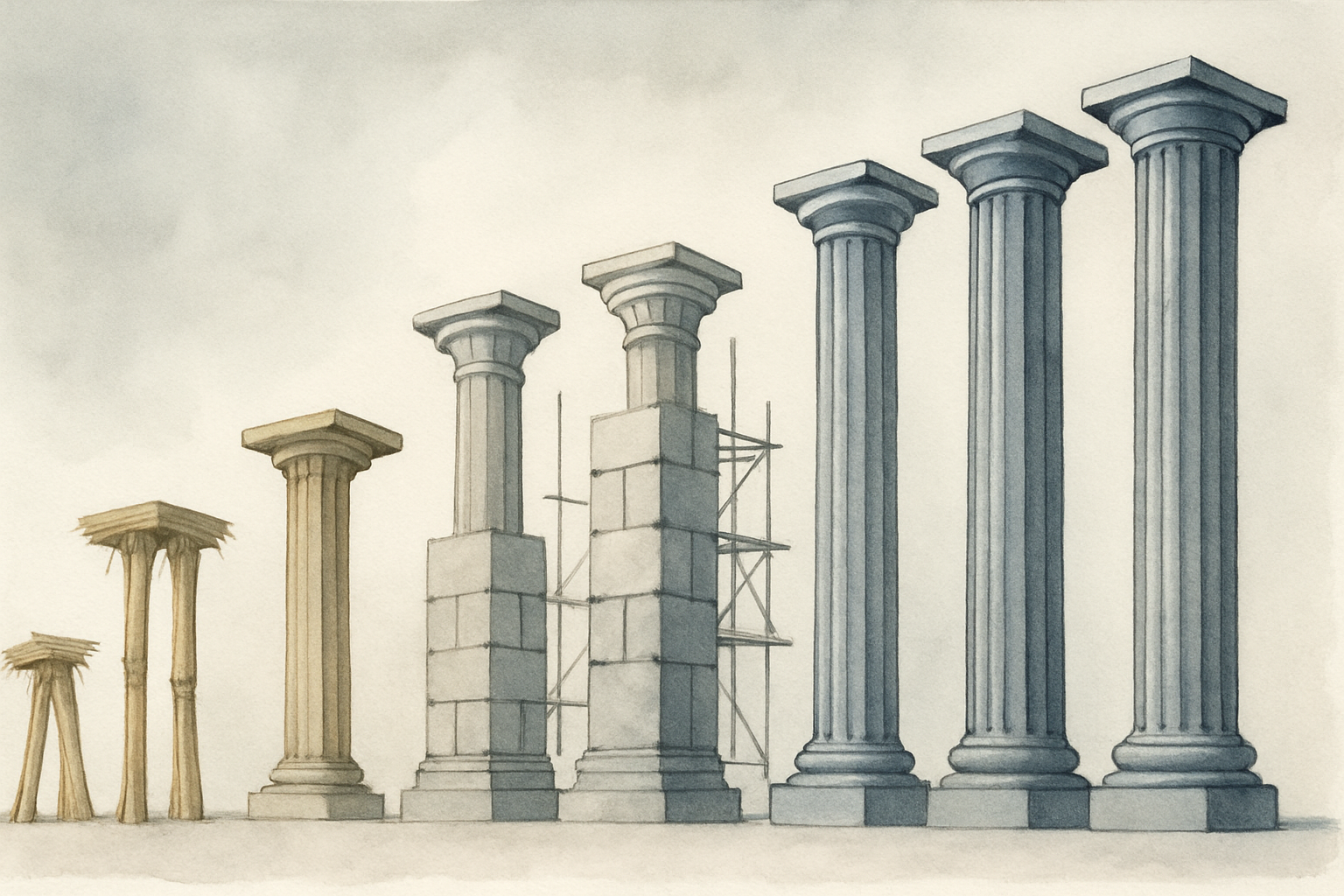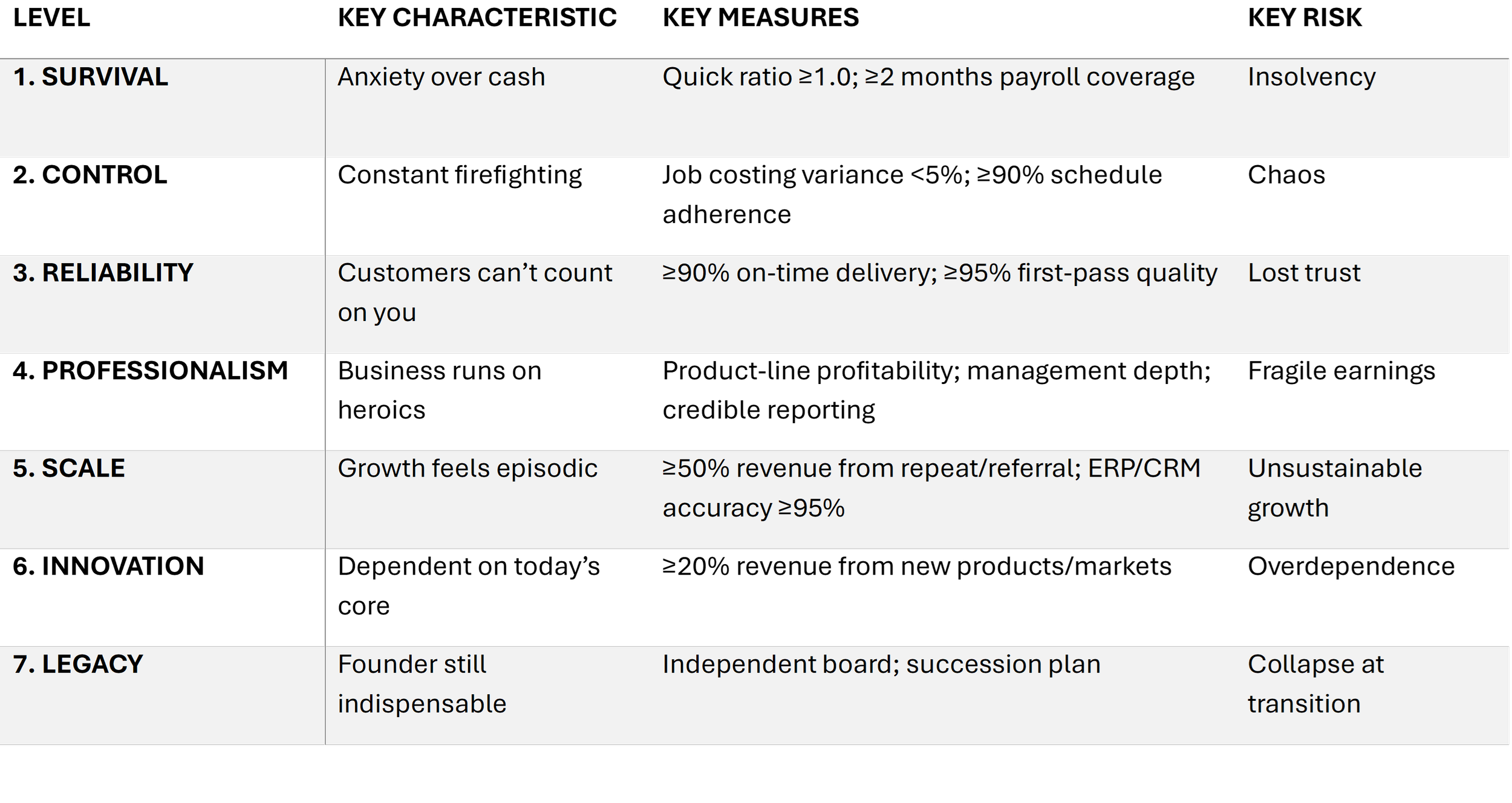
Insights on Value Capture and Growth Readiness
How industrial owners build resilience, attract capital, and capture the next layer of value before they sell.
PE Is Not Buying EBITDA. It’s Buying Confidence.
Private equity doesn’t buy earnings—it buys confidence. When investors look at a company, they’re underwriting its ability to deliver future performance, not just its past EBITDA. This piece explores how “confidence gaps” in systems, leadership, and reporting quietly discount valuation—and what owners can do to close them before they sell.
Markets do not reward history; they discount uncertainty
“We don’t pay for last year’s EBITDA. We pay for the confidence we can grow next year’s.”
The remark, delivered without theatrics by a mid-market private equity partner, is inelegant but accurate. Multiples are not a reward for past excellence; they are a probability-weighted forecast of future execution. In lower mid-market SMB industrial deals, the real negotiation is not over price but over conviction.
This is why the same company can receive wildly different valuations from different buyers. The spread is not sentiment; it is risk discounting. PitchBook estimates that fewer than three percent of owner-led firms successfully complete a traditional sell-side process, while capital concentration continues to narrow toward funds with scale and confidence in post-close lift.
McKinsey’s study Beyond the Hockey Stick finds that roughly ten percent of firms capture more than eighty percent of total economic value creation over a decade. The distribution is not linear; it is a power law, and private capital prices accordingly. The pricing function is therefore a risk-adjusted forecast: is this company one of the ten percent that can compound, or one of the ninety percent that will merely endure? The buyers that are still deploying are selective, not generous.
Underwriting is the sorting mechanism.
Owners think they are being judged; the risk they absorb is being underwritten
The key misunderstanding among owners in industrial SMB manufacturing is that investors are pricing the business as it exists today. They are not. They are pricing how much of today’s EBITDA will still be standing once the owner leaves the room—and how quickly a buyer can compound it thereafter. A clean P&L does not answer that question. A QoE cannot answer it either. Only the operating system of the company can.
The underwriting sequence is blunt. First: “Is this company durable without the current owner?” Second: “Can we institutionalize what works without overpaying for the privilege?” Third: “Is the growth story credible inside the four walls, not just in the offering memorandum?” The multiple is not a judgment of worth but an output of underwriting: the present value of future net cash flows and terminal value. It is then discounted by the capital injections and execution risk required to achieve them.
Growth is not rewarded; legibility is
In one recent diligence discussion, the room stalled on the simplest of questions: “What business are we actually buying?” The owner had healthy EBITDA, a loyal customer base, and sensible unit economics. The problem was strategic drift. Five initiatives were being pursued at once, each potentially attractive, but none coherent. What looked like optionality to the operator appeared as drift to the buyer. The haircut was not punishment. It was uncertainty, priced.
Bain’s research on adjacency moves in industrial firms finds that more than 70 percent of unfocused expansions underperform their core, not because the markets are unattractive but because the operating system was never built to carry that variety.
This is the quiet truth of lower mid-market industrial underwriting: most valuation erosion is not caused by obvious weaknesses but by ambiguous intentions. Buyers can underwrite a bottleneck in a manufacturing or industrial SMB environment. They can underwrite a thin bench. They can even underwrite cyclicality if there is discipline in cash conversion. What they cannot underwrite is a company without a crisp answer to “why this model, at this scale, with this focus.”
Owner-reliance is therefore not the root concern; it is merely the most visible proxy for something larger: concentration of judgment. When all strategic direction lives in one head, the buyer assumes execution risk remains unpriced. The same dynamic applies to firms with sprawling initiative sets, product creep, or half-adjacent expansions justified only by “customers asked for it.” The fear is not mismanagement. The fear is diffusion.
For investors, confidence is not a feeling; it is infrastructure. It shows up in routinized decisions, reliable reporting cadence, constraint-aware capital allocation, and a recognizably bounded strategy. Growth, in that context, is not a hope but a process, and what many owners call exit readiness is simply the point at which the operating system becomes legible to a buyer. The more predictable the process, the narrower the haircut.
This is why the best offers do not reward scale so much as clarity. A smaller firm with a defensible core and visible path to systematized expansion will often outprice a larger firm with a blurred identity. Size without focus is not resilience. It is leverage without a thesis.
The market’s selectivity is frequently misread as stinginess. It is better understood as underwriting discipline. When capital is choosy, ambiguity is expensive. What is being purchased is not the last twelve months of performance but the institutional momentum of the next thirty-six.
In the end, what is being priced is legibility.
A company easy to read is a company easy to scale.
Originally published on LinkedIn. Updated and republished here with additional insights.
When Growth Demands Its Price
Every company pays for growth—either in cash, capacity, or control. This article breaks down how growth amplifies weaknesses and what it takes to build systems that scale without cracking.
Growth is Faustian. It tempts firms with promises of wealth and power while concealing the risks that can undo them. Built on strength, it compounds resilience into cash, credibility and value. Built on weakness, it accelerates fragility into cash strain, chaos and mistrust.
Every owner wants growth. Bankers cheer it. Economists measure it. Yet growth is not salvation. It is an amplifier. It multiplies what already lies inside a business, exposing cracks as quickly as it rewards discipline. The question is not whether to grow, but whether the business can withstand what growth will amplify.
Growth pains
When liquidity is thin, growth tightens the squeeze. More orders mean more receivables, more inventory and less cash. This is overtrading: expanding faster than working capital can bear.
When discipline is weak, growth magnifies the chaos. “A few late shipments today are not going to improve if we double the volume,” warns Bill W., a warehouse manager. At ten million dollars in revenue, delays are irritants. At fifteen million, they are reputational damage. Reliability does not scale by itself.
When credibility is missing, growth breeds mistrust. “We are asked for larger facilities, but the cash flows can’t support it,” says a commercial banker. Customers share the concern, hesitating to place bigger orders with suppliers who fumble the basics. Hustle may carry a firm through its early years. But it does not scale. Without resilience—systems, discipline and focus—growth turns hustle into a liability.
Strength training
If liquidity is secure, growth generates cash. Fixed costs spread wider, operating leverage takes hold and incremental sales deliver more profit.
If reliability is high, growth deepens trust. Orders arrive on time. Quality is consistent. Reputation compounds. One satisfied customer becomes a stream of repeat and referral business.
Professional management builds credible growth. Transparent reporting and deeper teams reduce risk. “Once the numbers were clear and the team was deeper, we were comfortable lending more at better terms,” notes another banker. Growth not only expands earnings, it lowers the cost of capital and lifts valuations.
Fault lines under pressure
The Resilience Hierarchy, modelled on Maslow’s pyramid, sets out the sequence. At the base the constraint is liquidity. Then come control, reliability, professionalism, scale, innovation and, at the summit, legacy. Growth will amplify whichever constraint is unresolved. Liquidity gaps become cash crises. Weak governance becomes founder dependence. But once the constraint is solved, growth amplifies strength instead.
This is not a tale of good growth and bad growth. Growth is always growth. Its effect depends on the foundations beneath it.
Proof in the margins
Take a ten-million-dollar contract manufacturer. At first, more orders meant more late deliveries, more angry customers and less clarity on profitability. Expansion multiplied weakness. The firm then fixed reliability and professionalism. On-time delivery rose above ninety percent. Product-line profitability became clear.
When growth returned, it multiplied strength instead. Margins improved. Cash flow doubled. Bankers offered cheaper credit. “It finally felt like the business was working for us, not the other way around,” recalls the owner. Within four years EBITDA rose from one million to 2.3 million. Enterprise value climbed from 5.5 million to 13.8 million. Growth became a reward for resilience rather than a punishment for fragility.
Take one down, pass it around
The BluGrowth formula is simple: find the constraint, remove the constraint, repeat. Each time a bottleneck falls, another appears. Take one down, pass it around. Progress is steady, compounding, and focused. This rhythm turns growth from a source of anxiety into a source of wealth.
Growth is not a strategy. It is a force multiplier. Owners must ask what weaknesses growth will expose. Bankers must ask what strengths it will magnify. Investors must ask whether the returns justify the risks that growth will amplify.
The Resilience Hierarchy: A Framework for Enduring Growth
The Resilience Hierarchy outlines five levels of business maturity—from liquidity to legacy—that predict whether growth endures or collapses.
Resilience is not grit; it is the deliberate design of systems that prevent reliance on heroics.
Resilience has become one of the most valuable yet elusive qualities in business. It is often confused with grit. Grit asks individuals to persevere through adversity by sheer willpower. Resilience, in contrast, is about designing systems so that endurance is not left to human stamina alone.
The distinction is visible in polar history. The crew of the Endurance, led by Ernest Shackleton, survived only by extraordinary grit after their ship was crushed by ice. By comparison, Fridtjof Nansen’s Fram was designed with a rounded hull that allowed it to ride above the pack ice rather than be destroyed by it. The crew still faced hardship, but they did not need superhuman endurance simply to survive. The difference was not in courage but in design.
Businesses face the same choice. They can rely on grit—leaders and employees working harder, longer, and under increasing strain—or they can build resilience into the enterprise itself. The Resilience Hierarchy offers a framework for doing the latter.
The model adapts the logic of Maslow’s hierarchy of needs to the realities of business growth. But unlike Maslow’s psychology, which aims for self-actualization, the Resilience Hierarchy is built as a constraint system, with future free cash flow as the objective function. Every for-profit enterprise has the same ultimate goal: to increase free cash flow. This delivers money to owners, lowers the cost of capital, and raises enterprise value. The hierarchy exists to help leaders identify and address the constraint most likely to limit those flows.
The hierarchy identifies seven levels of resilience: Survival, Control, Reliability, Professionalism, Scale, Innovation, and Legacy. Firms may move up or down in response to shocks or changing circumstances. What makes the framework powerful is its discipline. At any given time, a company faces only one true constraint. Addressing it unlocks progress. Ignoring it creates fragility.
Resilience is the essential bridge between today’s stable cash flows and tomorrow’s growth.
Global capital markets remain abundant, with investors and acquirers seeking reliable returns. Two qualities consistently attract capital: stable cash flows today and credible plans to grow those cash flows tomorrow. Resilience is the bridge between the two.
Each level of the hierarchy lays the infrastructure to ensure that progress is not easily reversed. Liquidity cushions shocks. Reliability builds customer trust. Professionalism creates credibility in reporting and leadership. Scale turns growth into momentum. Innovation reduces dependency on a single core. Governance secures continuity across generations of leaders.
Empirical research supports this logic. Liquidity shortages are the leading cause of small business failure. Supply chain studies show that reliability, especially on-time delivery, is the customer’s most important expectation. Research on management practices confirms that professionalized governance and financial discipline drive productivity and higher valuations. And innovation research highlights the importance of optionality and bold bets in sustaining long-term value.
Each level of the hierarchy has a single constraint that must be resolved before moving forward.
1. Survival. Liquidity is the constraint. Metrics such as the quick ratio, payroll coverage, and line-of-credit utilization determine readiness to progress. Growth without cash is simply deferred failure.
2. Control. Visibility is the constraint. Firms must establish accurate job costing, reliable scheduling, and trustworthy inventory data. Without control, leaders are forced to manage by intuition.
3. Reliability. Customer trust is the constraint. On-time delivery, first-pass quality, and equipment uptime determine whether the company can be depended upon.
4. Professionalism. Management depth and accountability are the constraint. Product-line profitability, value-based pricing, and distributed leadership are prerequisites for institutional credibility.
5. Scale. Flywheel friction is the constraint. When repeat and referral revenue exceed half of sales and core processes remain stable, growth compounds rather than stalls.
6. Innovation. Optionality is the constraint. Resilience requires a portfolio of credible opportunities and the discipline to act boldly when the right one emerges.
7. Legacy. Governance is the constraint. Without independent oversight and succession planning, even well-diversified firms remain fragile.
Progress requires crossing each threshold in order; skipping levels leaves the business fragile.
The hierarchy functions as a diagnostic system, rooted in the Theory of Constraints, with free cash flow as the objective.
The Resilience Hierarchy differs from many frameworks in its diagnostic orientation. It does not prescribe universal best practices. Instead, it provides a logic for identifying where a firm is constrained and what must be addressed next. Every business is unique in its products, people, and markets. Yet the sequence of constraints is universal.
This design is consistent with the Theory of Constraints. At any point, one binding limitation governs the system’s performance. In the Resilience Hierarchy, that system is the business, and the performance measure is the ability to generate and grow future free cash flows. The hierarchy guides leaders to focus on the constraint most likely to limit those flows. Once that constraint is resolved, the next emerges, and the cycle continues.
For leadership teams, the practical benefit is clarity. Rather than diluting attention across many initiatives, they can concentrate resources on the one factor that will most increase resilience and cash-generating capacity. This sequencing reduces wasted effort, prevents premature expansion, and ensures that progress compounds rather than regresses.
Lower middle market firms benefit most from a disciplined focus on cash flow as the universal measure of resilience.
The framework is particularly relevant for firms in the lower middle market. These businesses are often too complex to rely on intuition yet too resource-constrained to absorb repeated shocks. Many are also family- or founder-led, which magnifies the importance of succession and governance at later stages.
For owner-operators, the hierarchy provides a roadmap that links daily decisions to the ultimate goal: higher free cash flow. Improving cash flow not only increases the money available to owners, but also lowers the cost of capital by strengthening lender and investor confidence. In turn, this raises enterprise value.
For investors, the hierarchy offers a lens for evaluating resilience and identifying where targeted interventions will create the most value. It frames every operational or strategic improvement in terms of its contribution to sustainable cash flows.
Resilience frees organizations from relying on grit by ensuring systems, not people, carry the weight of endurance.
The Resilience Hierarchy is both pragmatic and rigorous. By identifying and addressing the binding constraint at each stage, companies can move forward with confidence. They can withstand shocks, adapt to change, and compound free cash flows over time.
Crucially, resilience reduces the need for constant grit. Just as the Fram’s design spared its crew from the ordeal faced by Shackleton’s men, a well-constructed business spares its people from relying on endless stamina and improvisation. Grit may save a company in crisis, but resilience ensures it rarely needs saving at all. In an era defined by volatility, that design choice is the difference between surviving on courage and thriving on cash flow.




